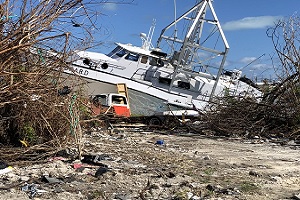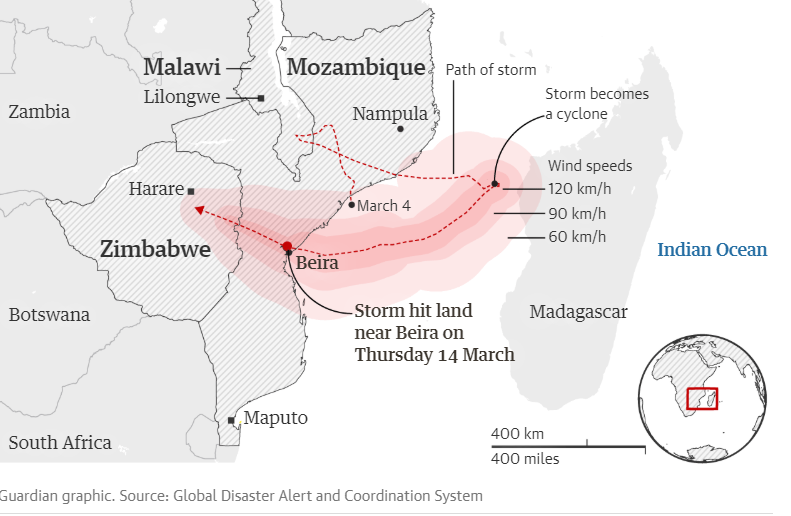VANUATU
On 7 April 2020, the Government of Vanuatu requested ITU assistance for satellite telecommunications equipment and connectivity after the devastation caused by category 5 Hurricane Harold that struck the country on 6 April 2020. Several islands of Vanuatu were devastated living a legacy of loss of lives and livelihoods. Almost 90% of the ICT terrestrial infrastructure was severely damaged, leaving Vanuatu without telecommunications links for several days, which impeded the coordination of response activities on the ground.


Hurricane Dorian struck the Abaco Islands, Bahamas as Category 5 hurricane on 1 September 2019. It was the most intense tropical cyclone on record to strike the Bahamas, and is regarded as the worst natural hazard in the country's history. It was also one of the most powerful hurricanes recorded in the Atlantic Ocean in terms of sustained winds, with these winds peaking at 295 km/h and its very low speed. ITU deployed satellite communications equipment to help restore vital telecommunication links after the massive devastation. Although mobile operators were able to restore their networks in a timely manner, rural areas did not have any type of connectivity. ITU's equipment was deployed to these critical areas.
SOUTHERN AFRICA
 |  |
Satellite telecommunications equipment was deployed to Mozambique and Zimbabwe after the severe devastation caused by category 4 Hurricane Idai. The hurricane hit Mozambique, the city of Beira, at about midnight on 14 March 2019 before striking the neighboring countries Zimbabwe and Malawi. The devastating hurricane that hit south-eastern Africa has been the worst ever disaster to strike the southern hemisphere. Hurricane Idai has caused devastating floods and has killed and injured thousands of people as well as crops, houses and roads. More than 2.6 million people could be affected across the three countries. Most of the districts are almost completely cut off. The satellite telecommunications equipment has been sent to the devastated areas where telecommunications are most needed for coordination of response efforts on the ground.
SOLOMON ISLANDS
In March 2019, ITU deployed emergency telecommunications equipment to Solomon Islands as a response effort after oil spillage in Rennell Islands. The heavy fuel oil had spread across the island’s sea and shoreline, and contaminated the water and impacted marine environment and human health. Rennell Island is one of the country’s remote islands with little infrastructure and few services. Following the request from the Ministry of Communications and Aviation of the Government of Solomon Islands, ITU dispatched Broadband Global Area Networks (BGANs) in the Solomon Islands that was used for coordination and response activities.
PAPUA NEW GUINEA
Emergency telecommunications equipment was deployed to Papua New Guinea after the devastation caused by a 7.5 magnitude earthquake struck on 26 February 2018, with its epicentre in Nipa-Kutubu district, Southern Highlands province. The affected area is sparsely populated, with a dispersed population living in remote, rural communities and affected an estimated 544,000 people in five provinces of the region. The strong quake caused loss of many lives and destruction to national critical infrastructures including telecommunication networks, health facilities, power lines and roads. Satellite equipment sent to support government's needs for communication, was used to coordinate activities for response, search and rescue efforts as well as recovery of vital telecommunication services.
TONGA
Emergency telecommunications equipment was deployed to Tonga after the destruction caused by Tropical Cyclone Gita, that hit the island on 12 February 2018. Gita was one of the most intense tropical cyclone to impact Tonga since reliable records began. Over 4,500 people were evacuated to temporary evacuation centres and over 1,500 houses were damaged or destroyed. The satellite telecommunications equipment was used to restore telecommunication links between the islands in order to coordinate response and recovery efforts.
CARRIBEAN ISLANDS
In September 2017, ITU deployed emergency telecommunication equipment to the Caribbean as a response effort after the massive devastation caused by Category 5 Hurricanes Irma and Maria. Many Caribbean countries suffered extensive damages from some of the strongest storms to hit the region in a decade. They affected telecommunication networks, power and water infrastructure, leaving many communities without water, food, power or communications.
Several Member States, including Haiti, Dominica and Antigua and Barbuda, received emergency telecommunications equipment, including satellite phones, BGANs and VSAT to support humanitarian relief and recovery efforts.
ZIMBABWE
In March 2017, ITU deployed emergency telecommunication equipment to Zimbabwe, following the request made by the Ministry of Information Communication Technology, Postal and Courier Services after the devastation caused by severe floods. Many homesteads and schools were destroyed and many lives were lost during this emergency. The equipment is being used to coordinate recovery and rehabilitation activities including providing communication to the most affected communities in the country.
HAITI
In October 2016, ITU deployed emergency telecommunication equipment in response to the devastation caused by Category 4 Hurricane Matthew, classified as the most powerful Caribbean Hurricanes in the last decade. Matthew caused many loss of lives and affected power and communication networks as well as transport roads, water and healthcare infrastructure. The government of Haiti used the equipment to support relief and coordination efforts as well as in assisting many communities that were totally affected.
SRI LANKA
In May 2016, ITU deployed emergency telecommunication equipment in response to the government of Sri Lanka request for assistance. Torrential rain caused loss of lives and destruction to infrastructure including telecommunications, power lines and roads. Many communities were affected and access to the affected areas were limited. The emergency telecommunication equipment provided include satellite phones, satellite broadband terminals and accessories, which are being used to support relief and coordination efforts.
ECUADOR
Emergency telecommunications equipment was deployed to Ecuador after the devastation caused by the 7.8 earthquake that struck the country on 26 April 2016. The ITU satellite equipment was delivered directly to the Manabi Province, the most affected area of the coast of Ecuador. The strong quake caused a lot of destruction to infrastructure including telecommunication networks, powerlines and roads. The emergency telecommunications equipment provided include satellite phones, satellite broadband terminals and accessories, which are being used to support search and rescue efforts as well as recovery and reconstruction activities .